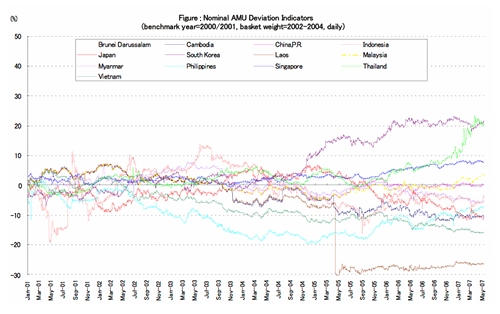It has been 10 years since the Asian currency crisis began with the fall of the Thai baht in July 1997. From their experiences with this crisis, Asian countries learned the hard way the need for financial cooperation with one another. For this reason, ASEAN+3 - consisting of the 10 member countries of the Association of Southeast Asian Nations plus Japan, China, and South Korea - has been promoting regional financial cooperation over the last decade. The twofold framework for the cooperation is comprised of the Chiang Mai Initiative (CMI) and the Asian Bond Markets Initiative (ABMI) which collectively address the development of Asian bond markets and funds. Under the CMI, a network of bilateral currency swap arrangements enables a member country hit by a currency crisis to borrow foreign currency from other member countries. These arrangements are thus defined as a scheme designated for the purpose of currency crisis management. During the latest ASEAN+3 Finance Ministers Meeting held in Kyoto on May 5, 2007 the currency swap arrangements were confirmed as being increased to $80 billion.
Currency crisis prevention is as important as currency crisis management. Thus, the Economic Review and Policy Dialogue, intraregional surveillance for the prevention of currency crises, has been conducted at meetings of ASEAN+3 deputy finance ministers under the CMI framework. However, this surveillance is primarily focused on domestic macroeconomic variables - such as Gross Domestic Products (GDP) and inflation rate - and soundness of financial sector, not on foreign exchange rates which are most closely linked with currency crises.
Under the ASEAN+3 Research Group initiative, research groups are set up annually at the ASEAN+3 Finance Ministers Meeting to study specific policy issues aimed at strengthening financial cooperation in East Asia. Through the groups' activities, it has been pointed out that exchange rates, which are currently not subject to surveillance, need be covered in order to closely monitor regional currency fluctuation. At the ASEAN+3 Finance Ministers Meeting held in May 2006 in Hyderabad, India, steps toward creating Regional Monetary Units were designated as one of the research themes for 2006-2007 in an effort to bolster monetary stability in Asia. The study on regional currency unit options under the ASEAN+3 Research Group initiative is to be continued in 2007-2008.
The Asian Development Bank has been studying an Asian Currency Unit (ACU), a notional unit based on a basket of Asian currencies. Meanwhile, as part of the RIETI project, "The Optimal Exchange Rate Regime for East Asia," headed by Faculty Fellow Takatoshi Ito, Junko Shimizu and I have been calculating and publishing an Asian Monetary Unit (AMU) and AMU Deviation Indicators as surveillance criteria for the currencies of the 13 ASEAN+3 countries1.
The AMU is a weighted average of these 13 East Asian currencies. As weight functions, we use GDP measured at purchasing power parity (PPP) and the arithmetic average of total trade volumes (the sum of imports and exports) for the three-year period from 2001-2003. We also considered nominal GDP and international reserves as possible weight functions. However, we decided to use GDP measured at PPP and average trade volumes because the AMU, in terms of value measured against a basket of the U.S. dollar and the euro weighted in accordance with the ASEAN+3 countries' trade volumes with the U.S. and the euro area (U.S. dollar:euro = 65%:35%), shows the greatest stability when based on these two weight functions (see Ogawa and Shimizu 2005). The AMU is estimated by the same method used for calculating the European Currency Unit (ECU) under the European Monetary System (EMS) prior to the introduction of the euro.
The AMU Deviation Indicator for each of the 13 East Asian currencies is calculated using the formula below, with the deviation indicator for each currency in the benchmark period set at 0%.

In order to determine the AMU Deviation Indicator, it is necessary to define the benchmark period. From the 1990s onward, both the intra-regional trade of the ASEAN+3 countries and their trade with countries outside the region were most balanced in 2001. Based on this and taking into consideration the effect of time lag before exchange rate changes affect trade balances, the two years from 2000-2001 have been chosen as the benchmark period.
The figure provided below (see http://www.rieti.go.jp/users/amu/en/index.html for more details) shows changes in the nominal AMU Deviation Indicator of each of the 13 East Asian currencies, i.e., changes in the degree to which each currency deviates from the AMU compared to the benchmark period. This figure shows that the deviation has been visibly widening for East Asian currencies in recent years. For instance, the South Korean won has been overvalued since early 2005, and the Thai baht has shown a sudden upward movement toward overvaluation since the end of 2006. On the other hand, the Laotian kip was substantially devaluated in May 2005 and has been remaining undervalued while the Vietnamese dong has been gradually moving toward undervaluation. Most recently, gaps in the nominal AMU Deviation Indicators among the East Asian currencies have been viewed as large as just below 50 percentage points.
As a future project, we are planning to expand this study on the AMU and AMU Deviation Indicators, which currently focuses on the AMU as a Regional Monetary Unit for the purpose of surveillance, to explore the AMU's possibility as a presentation currency particularly for private-sector securities issuers, particularly, those of the Asian bond.



